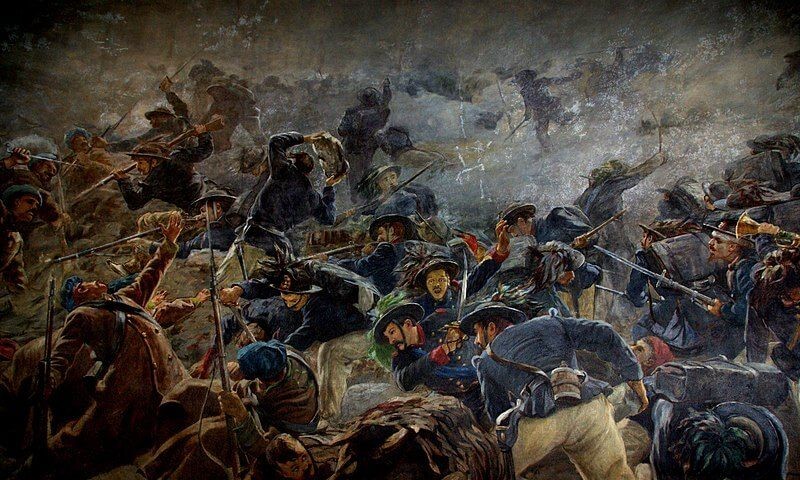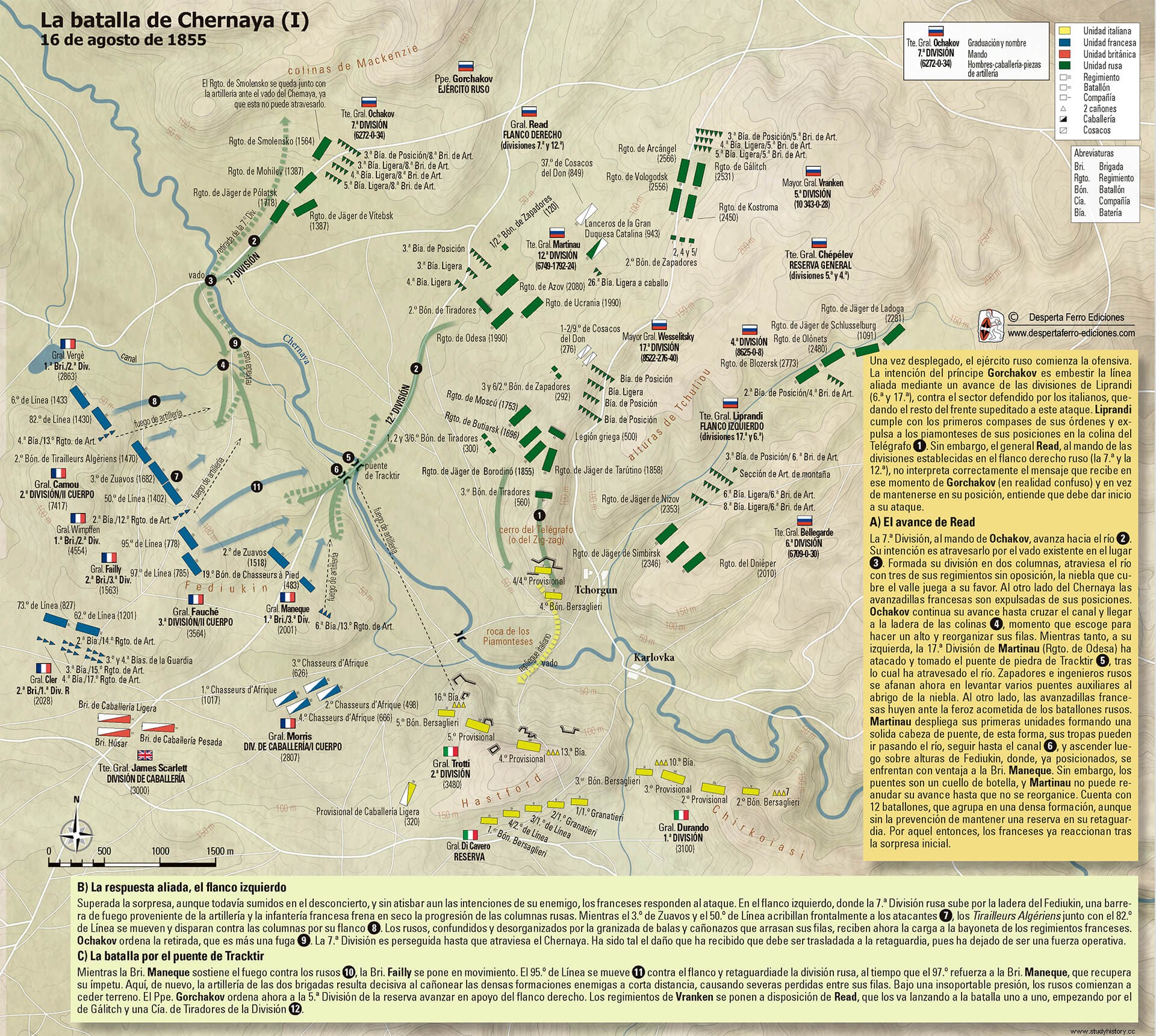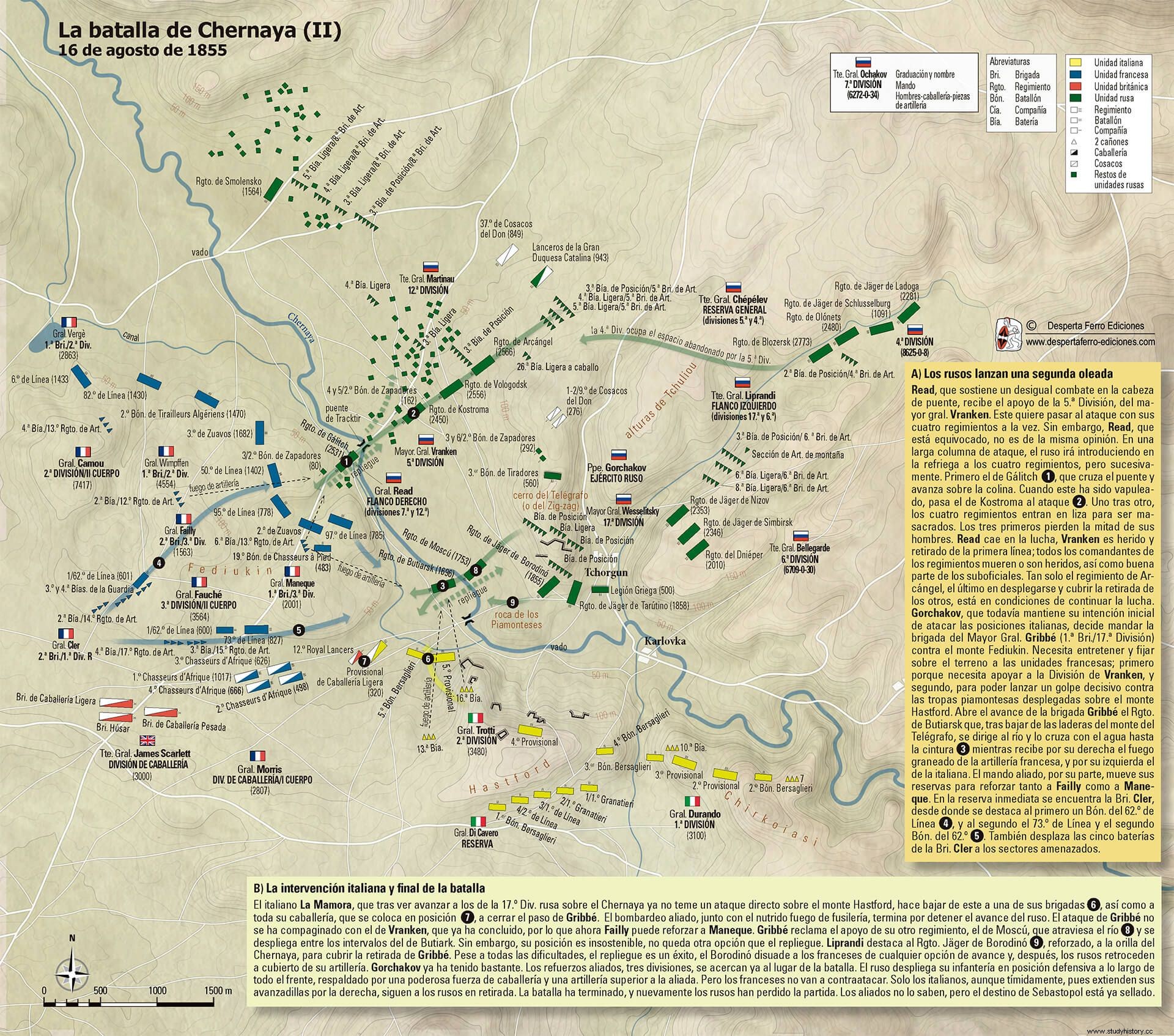
From four in the morning to the afternoon of On August 16, 1855, the Battle of the Chernaya River took place on the Crimean peninsula, on the outskirts of the besieged Sevastopol. , the last Russian attempt of consideration, after the fiascoes of the battles of Balaclava and Inkerman, to dismantle the allied device around the city. The river bordered a number of strategic points of enemy deployment:the Fediukin Mountains, Hastford, Tracktir Bridge, Telegraph Hill, and the village of Karlovka.
The Prince Mikhail Gorchakov , commander in chief of the Russian operation, had to face the objective of achieving an advance in a battle front of about 9 kilometers. Since the end of July the Russian general had received numerous reinforcements that would be used for the capture and crossing of Chernaya. The tsarist officer was under great pressure, he had the difficult task of retaking the Russian positions that would have been conquered by the allied contingent a few months earlier. He now had reinforcements from the 4th, 5th and 7th Infantry Divisions, plus seventeen militia units, seven irregular druzhina type units and two regiments of jäger .
On August 15 he arranged the movements that should take place in the following hours. On the Russian right, to the left of Mount Fediukin from the Allied perspective, were General Read's troops, with the 7th and 12th Divisions. He had Generals Ochakov and Martinau under his command. They included the Mohilev, Vitebsk, Polotsk, Azov, Ukraine, and Odessa regiments, as well as members of the 2nd Sapper Battalion, Uhlan squads, Cossack regiments, and some sixty-two artillery pieces. Gorchakov's left front was led by General Liprandi. The latter had Generals Wesselitsky and Bellegarde (13th and 6th Divisions) under his command and had notable units such as the Borodino, Butirsk, Moskovia, Nisowsk and Simbirsk regiments. It was also reinforced by units of sappers, Cossacks, and 56 cannons. This was not the entire Russian contingent, as the prince had arranged a reserve corps under the command of Lieutenant General Chepelev (the 4th and 5th divisions).
The Spanish observers Tomás O'Ryan and Vázquez and Andrés Villalón witnessed the large Russian deployment for the Battle of Chernaya from the Anglo-French point of view, and estimated in their study Report on the military trip to Crimea, presented by the officers of the Corps of Engineers appointed in 1856 to follow and study the operations of the war between Russia and the Western powers France and England, aiding Turkey (1888) that, only in the sum of both Russian flanks, seemed to have about forty thousand men.
The Russian advance
If all went according to plan, the tsar's troops would regain control of the other shore of the Chernaya, with the plain of Balaclava, and would threaten the English supply lines, in addition to returning a breath of hope to their comrades surrounded in Sebastopol. On the 15th the Russians began their deployment and preparations, General Liprandi positioned himself near the heights of Mount Tchuliou, a short distance from General Bellegarde's troops. In the early hours of August 16, 1855, Liprandi sent some horsemen and advance guards to explore the river, the shallower areas and the location of the enemy detachments. Gorchakov was clear that the 7th and 16th divisions had to ram and drive the Italians out of their positions on the Russians' left flank.
This last flank advanced to take the immediate hill, the town of Karlovka and the Hastford position. Before a fog that did not give respite to the allies and favored the Russian forces, Liprandi took Telegraph Hill. Gorchakov had indicated to his generals that he himself should indicate the central objective of the attack and allow the advance of his different army corps, but a confusion made General Read's flank advance ahead of time. Spotting the advance of his compatriots on his left flank, Read understood this to be his advance signal from his commander-in-chief, Prince Gorchakov, and ordered the advance over the slopes of the Fediukin and the ford to the left of the same. It would be the first tactical error of the battle by the Russian contingent.
Instants before, with the first advances of General Liprandi, the capture of Mount Telégrafo was achieved and the Sardinian troops retreated and started the crossing in retreat. The Russian arranged the artillery for him and harassed the Italian advance guards for three-quarters of an hour; after that, and under the protection of the fog, he sent a bayonet charge on them. The Italians withstood the first Russian wave, but the number of troops and their momentum was such that they had no choice but to retreat to cross the ford near "the rock of the Piedmontese". The Marmora , the Italian general in command of the Army of the Kingdom of Sardinia, arranged for the famous Bersaglieri (specifically the 4th Battalion) to cover the retreat.

The Russian right flank , headed by General Ochakov, was approaching the channel through the previous undulations. At 1,500 meters from the enemy, their gunners roared their cannons, and the allies could see the many muzzles that seemed to spit fire that early morning. Both these last pieces and those of Liprandi prioritized the fire on the enemy artillery instead of on the infantry, which would be another big mistake. In turn, General Martinau advanced with his 12th Division to take the Tracktir bridgehead, where he would suffer heavy losses from Italian and French artillery. The French generals Maneque and Fauché were in charge of protecting the pass, and many of the most important casualties occurred at this point. The Russian 12th Division was reaching the bridge to unleash rifle fire on the French.
The Chernaya river crossing caused all kinds of difficulties:in addition to the ford and the bridge, they had to make use of pontoons and ladders with the help of their sappers. The case of the 7th Division, to the right of the 12th, was by no means easier. They reached the camp of the Gallic general Camou, which meant an achievement, but the French reaction after the surprise of the initial attack was not long in coming.
Camou, given the need to offer uncompromising resistance , arranged his elite units on the slopes of the same mount (left of the Fediukin):the Zouaves and the reinforcements of another French general, Wimpffen. In its entirety, the French front was made up of:line infantry, Zouave battalions, Algerian skirmishers and artillery. The 82nd, the 50th, the same Zouaves and other units had the opportunity to charge against the Russian enemy, already punished by the artillery, thus being able to force their withdrawal through the Chernaya channel, which in turn caused the disorder in Read's forces and their retreat through the sector they had gained control of a few moments before. That was a contradiction. Louis Napoleon's troops were no longer the bewildered and frightened soldiers the Russians thought they were dealing with. The 7th Division was totally disabled. So much so that the commander-in-chief, the prince, would order Major General Vranken to cede units of the reserve corps to Read in order to try, in some way, to save his flank and the withdrawal of Ochakov's units, which finally it turned out to be an attempt to work around his failures on the right flank, thereby increasing his performance on the bridge (to the left of what had been Ochakov's advance).
In the Tracktir step, the French general Maneque and his units obtained a special role. After volleys of rifle fire, they led the advance before the Russians and the bridge. After all these havoc, the Russian setback was already beginning to be a fact . Read's reinforcements charged in different waves on the bridge thus undertaking a suicidal action, a fatal decision that General Vranken would comment on that August 16. The allies watched as numerous regiments broke ranks and fled across the main bridge of the Chernaya. Read himself and several of his assistants were hit and killed, which was aggravated by the Allied artillery tactic, which consisted of focusing fire on the masses and not on the enemy pieces.
French counterattack at the Battle of Chernaya
The first officer to spot Liprandi's movements and his observers on August 15 was General Allonville. The Allies owe him the intelligence that reached the ears of Generals Pélissier and Émile Herbillon, who in turn gave the warning to the remaining Allied forces:starting with the command of the main division, General Fauché.
When General Pélissier became aware of the continuous waves of Read and his desperate situation, he wanted to be the hero of the moment and charge the retreating enemy with cavalry. Besides, his people had been the first to repulse the Russians, and he wanted to be a part of the occasion. The Frenchman finally gave up, because he knew that Gorchakov and part of his artillery were still standing and that they could cause him significant casualties; he possibly had Ney's fatal charge at Waterloo in mind.

In the battle of the Chernaya river the advantage of the The French consisted of their highest position and having numerous parapets, trenches and defensive positions that, on the other hand, made it difficult for them to see the enemy, which was aggravated that day by the fog that helped the Russians so much . On August 16, 1855, the French had elite units such as the Zouaves and the artillery of the Garde Impériale His troops were estimated to be around 18,000 soldiers, according to Spanish observers. Of crucial importance was the perseverance of the French on the river and the systematic use of their artillery, as we have already mentioned, in conjunction with the Piedmontese. In the same way, the reinforcement offered by the Allied General Staff to stabilize the positions of the Tracktir bridge and the slopes of the Fediukin established the point of no return for their enemies. The allies established their positions with exceptional calm, if we take into account the surprise attack to which they had been subjected.
Carica alla baionetta, vittoria!
La Marmora commanded General Di Cavero's reserve division, Durando's 1st Division and General Trotti's 2nd Division, mostly known as “Trotti” Division. Let us remember that the Italians had lost their outposts and, protected by the Bersaglieri, were forced to retreat across the river to their positions at Hastford and Chirkoiasi. When the regiments of jäger Simbirsk and Borodino advanced at dawn, the first thing they encountered was the brave Italian soldiers from the Chorgun redoubt, on Mount Telegraph. With fixed bayonets , the Italians were ready at all times to charge under their banner, so much so that in the face of numerous Russian advances and before being forced to retreat, they made as many charges as they could against their enemies.
The Marmora had a clear image in their mind:they must move forward and deal as much damage as possible with their artillery to the waves charging against the bridge. The fact that the Russians did not attack the Hastford positions and did attack those of Tracktir allowed the Italians to maneuver more freely, and enabled them to displace various components of the Trotti Division, such as the Bersaglieri 5th Battalion and the cavalry light, which was reinforced by the English 12th Lancers Regiment, which was intended to ensure the passage of their French allies, and if necessary, block a Russian advance. A few hours later, only Gorchakov's own units were able to offer a last resistance until one in the afternoon, highlighting the remarkable action of the Borodino Jäger Regiment. Finally, the firmness of this tough Russian unit made the Allies reconsider the idea of a possible advance. Thanks to this, the Russians, under the covering fire of their cannons, were able to withdraw, falling behind a timid pursuit by Sardinian troops.
Battle of Chernaya Balance
The Russian failure in the Battle of the Chernaya River It has gone down in history for several reasons:from the numerical difference to the systematic pointless withdrawals by its troops. The subsequent armistice lasted two days, in which the different forces were able to bury their dead. It was a surprise to many that Read had fallen, but he hadn't been the only one. Baron Brewski's aide-de-camp and the Russian General Weimar were found in those days. In all, the Russians had suffered some 8,000 casualties (dead, wounded, and missing), including 11 generals and 249 officers; the allies for their part, did not reach a quarter of that of their enemies.
The action of the Bersaglieri Regiment It was a clear example of courage. In addition to all this, it is necessary to mention the contribution of the Sardinian and English artillery together with the French. It was their decision not to return the Russian cannon fire and to focus on the enemy infantry that gave the Allied forces a crucial advantage. Many years later, the Battle of Chernaya on August 16, 1855 comes to mind as a battle full of errors and heroics.
Bibliography
- O' Ryan, T and Villalón, A. (1888):Memoir on the military trip to the Crimea, presented by the officers of the Corps of Engineers appointed in 1856 to follow and study the operations of the war between Russia and the Western powers France and England, helping Turkey . Madrid:Press of the Memorial of Engineers.
- VV.AA. (2019):The Crimean War (I). Balaclava. Awaken Ferro Modern History No. 38. Madrid:Awake Ferro Editions.
- VV.AA. (2020):The Crimean War (II). The site of Sevastopol. Awaken Ferro Modern History No. 47. Madrid:Awake Ferro Editions.
